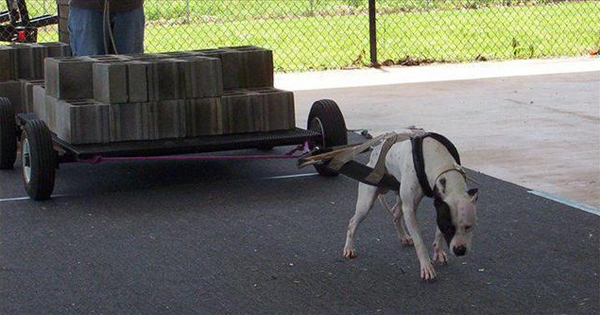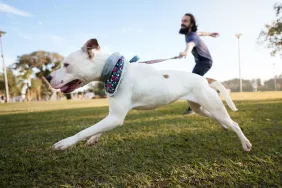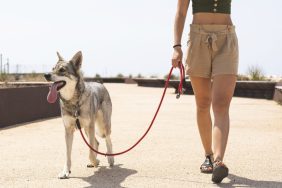Is it a healthy way to exercise a dog, or a dangerous activity that borders on animal abuse? Either way you slice it, weight-pulling is a dog sport that certainly has people talking.
Dog weight-pulling is essentially the canine version of the tractor pull. Others have compared it to powerlifting or strongman competitions.
Competing dogs are tethered to a wheeled cart by a special harness, and they must use their body strength to pull increasingly heavy loads, usually consisting of concrete or bricks. For each timed round, the weight-pulling dogs must drag their loads a total of 16 feet down a track. The dog who manages to pull their load the required distance in the fastest time wins. Each competing dog’s owner or handler makes no physical contact with their pooch during the rounds; they must stand in front of the animal and coach it forward.
Owners who take their dogs to participate in weight-pulling claim the activity promotes a healthy owner-dog bond and is great exercise. Working breeds who were originally bred for this kind of activity find weight-pulling especially beneficial as it helps them expel their energy, sport supporters say. The American Pulling Dogs Association (APDA) explains that pulling activities are a great method of curbing problem behaviors in dogs.
“In the light of the changes over the last 40 years in our lifestyle, culture, personal activity levels and the lack of time available in working households, we see more and more dogs who have an exercise requirement that is difficult for some owners to fulfill, which can lead to various issues,” the APDA website explains. “Dog professionals in some areas have found a different type of exercise, specifically weight-pulling, to be not only easier for many clients to provide, without a high investment of time, money, and equipment, but have also shown significant improvements in various behavior problems as well.”
Behavioral problems that often land dogs in shelters — problems like aggression, pacing, shyness, hyperactivity, reactivity, or other repetitive, obsessive-compulsive behaviors — can be vastly improved when dogs are given an energy outlet like weight-pulling, APDA argues.
Back in 2012, Hillsborough, Fla., Animal Control Director Ian Hallett decided to allow some of the Pit Bull Terriers in his shelter facility participate in a local weight-pulling event for exactly that reason.
“Well, one of the things I’m really concerned about is that working breeds and sport breeds are being surrendered to animal shelters left and right around the country, and it could be prevented through more rigorous exercise,” Hallett explains.
But former Seminole, Florida Commissioner and animal advocate Dan Hester told CBS 10 News that when he learned of the practice, he was disturbed.
“To me, it is wrong,” Hester said of dog weight-pulling. “I’m not saying it is illegal, but I am suggesting in the 21st century, that’s not the way you treat what’s meant to be a companion animal.”
When Hester learned that the Hillsborough Animal Shelter let their Pit Bulls compete in weight-pulling activities outside of the facility, he bristled.
“Taking an animal out of Hillsborough County Shelter to a quasi-public event to demonstrate how strong that dog is…there is something wrong there with that thinking,” Hester says.
Critics of the sport argue that the sheer amount of weight dogs pull in these competitions is enough to cause severe harm to the animal.
During a recent International Weight Pull Association (IWPA) event in Riverton, Connecticut, dog owner Todd Sheehan competed with his 103-pound Alaskan Malamute, Valiant, who managed to pull a cart stacked with concrete blocks nearly 10 times his body weight. Though Valiant won the competition, pulling more than 1,000 pounds behind him, Sheehan expressed frustration that his dog couldn’t pull 1,200 pounds instead.
“He still needs work,” Sheehan tells Aljazeera of Valiant. “He’s gotta stop backing up and stepping out of the harness.”
In a YouTube video posted back in 2011, competing dogs Teka, an American Bulldog, and Blaze, an American Pit Bull Terrier, both managed to haul a load of giant bricks more than 5,000 pounds.
Pulling such heavy loads could lead to serious injury, opponents argue, including muscle strains, muscle tears, or joint damage.
“It can be extremely dangerous to dogs,” says Lindsay Rajt, spokesperson with People for the Ethical Treatment of Animals (PETA), “especially if they haven’t been conditioned or trained for it. The other concern is when you have owners that are more focused on winning than the safety of their dogs.”
Veterinarian Robert Gillette admits weight-pulling, like any strenuous athletic activity, does carry a risk of injury. He recommends a proper conditioning regiment and harness. But critics even frown upon some of the training methods used.
Enzo Cullotta, a weight-pulling judge from St. Charles, Illinois, has owned many American Bulldogs who have competed in pulling events. Cullotta says that he starts training his dogs to pull at four months of age by having them drag heavy chains. He also trains them further by tethering his dogs to his bicycle and running them for six miles at a time.
“They’re not just a pet,” he says. “They’re a machine. When they got it, it just makes it so much fun.”
Rajt sees a connection between weight-pulling and illegal dog fighting, telling Aljazeera that there have been cases in the past of dogfighting suspects using weight-pulling as a cover because of the similarity in training methods and equipment.
While dogs of any size and breed can compete in the sport, Pit Bulls have become the most popular because of their muscular appearance and, in some cases, their reputation as the tough guys of the dog world. But this could potentially attract people seeking premium fighting dogs, opponents worry.
Critics like Rajt also claim that weight-pull breeders will aim to push their dogs to the limit in order to sell puppies sired by top competitors for unbelievable amounts of money.
“Why can’t you just value the animal for the companionship that he offers?” Rajt asks.
Sources: Aljazeera, CBS 10 News, APDA website









